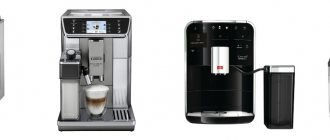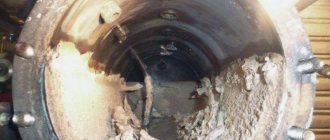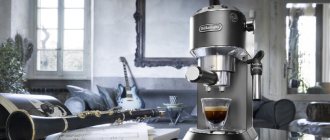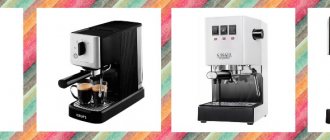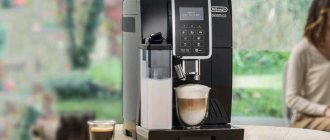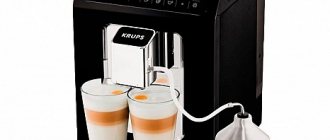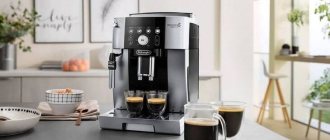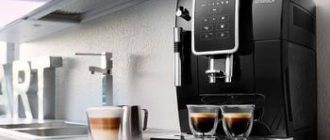Coffee is one of the most popular drinks today. Many people are used to starting their morning with a cup of invigorating espresso or cappuccino. The cost of ready-made coffee is quite high, so many users have adapted to working with special machines - coffee makers. They are a universal device that can quickly and efficiently prepare several types of coffee. In this article we will talk specifically about an espresso coffee maker. A carob coffee maker copes well with the process. Models are available for use in the office or home. We will take a closer look at the ranking of the best and learn important tips to help you make a successful purchase. Happy reading!
Steam engines
In 1884, at an exhibition in Turin, Angelo Moriondo presented “a new steam engine for the economical and rapid preparation of coffee drinks.” Thus, the method of preparing coffee under pressure was born.
Electric steam coffee machines are still in use today. Simplicity of operation makes them easy to handle and manage, they are affordable and compact. What is the principle of their work?
In a sealed container, water is brought to the boiling point and steam is produced. This creates pressure that forces the water through the reservoir and into the coffee. This is similar to what happens inside a geyser coffee maker.
The disadvantage of steam machines is their low pressure of only 1–1.5 bar, while the ideal pressure for espresso is 9 bar.
©https://www.perfectdailygrind.com
In these machines, the water used to create steam is also used to brew coffee. This means that the water is almost boiling when it reaches the beans, and this can lead to over-extraction and ruin the taste of the coffee.
Coffee extraction is the process of dissolving coffee particles in water. To achieve a good taste of a coffee drink, there must be proper extraction, which depends on the amount of coffee, grind, preparation time and temperature. Wikipedia
Iván Mora, a barista at Hola Coffee in Madrid, says steam machines “not only have low pressure, but also very high temperatures.”
A steam coffee machine is a good choice if you want to save a little money and don't want to go through the hassle of learning how to make espresso like a barista in a coffee shop. By experimenting with the grind size, you can find a way to make good coffee without over-extracting.
©https://www.perfectdailygrind.com
Best Espresso Coffee Makers
The TOP best included the following models:
- GAGGIA CAREZZA DELUXE;
- ASCASO DREAM GROUND (2013);
- SMEG ECF01;
- DE'LONGHI EC 820 B;
- KENWOOD ES 020;
- KRUPS XP 3440;
- VITEK VT-1514.
We suggest you look at their more detailed descriptions, characteristics and user reviews.
GAGGIA CAREZZA DELUXE
The first line of the rating is occupied by a functional model made in retro style. The device has a number of features: a sound signal notifying about scale accumulation, a double-wall filter and the ability to work together with ESE briquettes. The coffee maker has a classic milk frother in its design. It helps you quickly and easily prepare rich foam with increased density. The steam type nozzle rotates 180 degrees. Many users note the very convenient functions of pre-wetting and automatic shutdown.
| Dimensions | 21x30x28 cm |
| Water tank capacity | 1.25 l |
| Power | 1900 W |
| Pressure | 15 bar |
| Design | retro style |
Price: from 18,000 to 20,000 rubles.
pros
- good power indicator (1900 W);
- there is a function that provides heating of cups;
- presence of water level and temperature indicators;
- pressure has an upper limit of 15 bar;
- There is a special tray for collecting drops.
Lever coffee machines
Lever mechanisms require physical strength to make coffee. There are two types of mechanisms: manual and spring.
A manual machine can be recognized by the horizontal position of the lever. When it is raised, preheated water is poured into the cooking chamber, which interacts with the ground grain. The barista can control the duration of the pre-wet process, flow rate and pressure by pressing a lever.
On spring-operated machines, the lever points upward when the inner spring is relaxed. When the lever is pressed, the spring compresses and raises the piston. This opens the cooking chamber for water to enter.
The lever rises and the spring releases the tension, the piston pushes the water down and the espresso is prepared.
©https://www.perfectdailygrind.com
With lever machines, the barista has everything under control. If a certain coffee needs a longer pre-wet, or requires a certain pressure profile to achieve flavor, this is not a problem. These machines give freedom for creativity and experimentation.
Lever coffee machines are attractive, and the lack of electrical components can be an advantage. They're not as common today and certainly wouldn't be suitable for a busy coffee shop, but if you want to make steampunk coffee, this is the machine for you.
©https://www.perfectdailygrind.com
But why does making espresso have to be a complicated process? Lever coffee machines require physical effort and an understanding of how to control variables. But such complete human control can lead to instability in taste.
Most lever coffee machines only have one boiler and rely on the water to cool down before interacting with the coffee, which can lead to inconsistent results.
Sean Aupiais is the founder of the Red Band Barista Academy in the Eastern Cape (South Africa). He says he values stability. “When it comes to buying equipment, there are always a lot of pros and cons, but stability for me is definitely one of the most important selection criteria,” he says.
©https://www.perfectdailygrind.com
Best Espresso Machine Brands
The shelves of home appliance stores are replete with dozens of manufacturers with hundreds of models of coffee machines. The choice is mind-boggling, not to mention confusing. We have compiled a list of the most reliable brands for you. All of these manufacturers have a solid reputation as creators of high-quality household appliances at reasonable prices.
De'Longhi
De'Longhi has been around since 1902. This family business produces kitchen equipment and small electrical items, including a wide range of high quality coffee machines.
Nespresso
Nespresso is a very famous manufacturer of espresso machines. Many of us have seen George Clooney advertising this brand's coffee machines on TV. The machines of this manufacturer have proven themselves to be excellent espresso machines.
Hamilton Beach
Hamilton Beach is a small American company that designs, markets and distributes a wide range of home and commercial kitchen appliances. They make high quality espresso machines and have a growing reputation as a budget brand for home appliances.
Bialetti
The Italian company Bialetti has been producing high-quality espresso machines since 1933. Over the years, Bialetti has established itself as a manufacturer of first-class coffee sets and other small household appliances. You can't go wrong if you invest in one of the amazing home espresso machines.
Bella Housewares
Bella Housewares makes tableware for the modern woman who is short on time. They take pride in creating small, efficient kitchen appliances that help in the kitchen.
Capresso
Capresso is a Swiss company that produces high-quality espresso machines, coffee grinders, coffee makers, frothers (cappuccino makers) and kettles. Their products are not cheap and are aimed at a discerning audience who is serious about homemade coffee. However, if you want to make the right coffee, and you want excellent technology that will last for years, Capresso is your choice.
Breville
Australian company Breville has been around since 1957 when they started business as an importer of white goods. Breville supplies everything from sandwich makers and irons to espresso machines. Breville is an excellent supplier of budget but quality coffee machines.
Cuisinart
Cuisinart is a world-renowned manufacturer of kitchen appliances, including home coffee makers. This American company has been around since the early 1970s and has a solid reputation for producing decent quality coffee machines at affordable prices.
Gaggia
The British company Gaggia specializes in the manufacture of high-quality coffee machines, mainly for home use. While you may pay a hefty amount for one of the espresso machines, the investment will pay you back for a lifetime of high-quality coffee.
Rancilio
Rancilio was founded in 1927 in Italy. Since then, they have been producing espresso machines for the commercial market, although they also offer a machine designed for home use. Experience gives Rancilio the ability to produce coffee machines with superior design and performance.
Frequently asked questions (FAQ)
Our guide wouldn't be complete without an FAQ section. Here we will try to answer questions that every self-respecting home barista should know.
Question: Can you make espresso without a machine? Answer: Yes, you can make espresso without a machine, you will need some tools, coffee maker or Aeropress, ground coffee and just follow the instructions on our website... Q: Why are espresso machines so expensive? A: The simple answer to this question is: “You get what you pay for.” Decent quality espresso machines and coffee grinders are high-tech, high-tech packages. Coffee machines are designed and manufactured to perform complex operations, using steam, hot water and high pressure to precisely grind coffee beans. Essentially, you are buying an industrial grade tool rather than standard kitchen equipment. Q: What kind of espresso machine does Starbucks use? A: Most Starbucks stores currently use the Mastrena High-Performance Espresso Machine, which is a fully automatic coffee machine. This machine grinds the right amount and fineness of coffee beans for each specific cup of coffee, ensuring that the taste and aroma of the beans are preserved. With this machine you will also get high-quality grinding for your espresso. This will be much better than coffee prepared using machines that use pre-packaged, ready-made coffee. Q: What is a heat exchanger in a coffee machine? A: Heat exchanger means there is only one boiler in the machine. The machine has one element that can provide two different temperatures, one lower temperature for brewing coffee and another higher temperature for frothing and dispensing hot water. This means you can brew and steam at the same time. Q: Why tamp coffee? A: Once you have poured the ground coffee into the filter, it needs to be compacted. Tamping means compacting the coffee grounds evenly. Press too hard and the water flow will be slow, resulting in a more bitter coffee. Insufficient density will not allow you to get sufficiently aromatic coffee. Finding the perfect one takes practice, but it also depends on your personal taste. Q: Do I need to descale? Oh yes yes! Limescale can render your coffee machine unusable. The method for removing deposits depends on the brand and type of coffee machine you have. Read the user manual to understand how to do this. At the very least, clean every couple of months to remove scale, but if you live in an area with very hard water, do it more often. Q: Is a good grinder important for quality espresso? A: Absolutely! A bottom grinder will damage your coffee grounds by burning oils before you've even brewed your coffee. No matter how high the quality of the espresso machine or the beans themselves, if the grinder is bad, the coffee won't be great either.
Pump coffee machines
Pump espresso machines have been around since the 1960s and dominate the market. During operation, an electric pump directs hot water through the brewing chamber into the cup of coffee. When using an electric pump, it is easy to achieve a constant high pressure.
Today, there are three main categories of pump coffee machines: semi-automatic, automatic and super-automatic. They all differ in the type of pump, number of boilers and electronic control. But let's look at each type before moving on to the mechanisms.
©https://www.perfectdailygrind.com
Care and maintenance of Espresso machines
If you want to continue enjoying great, flavorful coffee from your new machine, you can't just brew coffee. You need to clean it regularly. The essential oils that coffee beans contain provide the aroma of your espresso. But the oily residue is gradually deposited on the insides of your coffee machine. Oils also leave a film on filters. Ultimately, this film blocks the filter holes. The accumulated oil deposits end up imparting an unpleasant, bitter aroma to your coffee. Keeping your car clean will extend its life.
Tips for cleaning your Espresso machine
There are several basic cleaning tasks that you should perform daily. Clean and wipe up splashes of water and steam after each use, and run water through the machine after each preparation. Clean the water tank after every 10-15 uses. Once a week or every 20-30 preparations you will need to perform a more thorough cleaning procedure as described below. Before cleaning your new espresso machine, check the manufacturer's instructions in the owner's manual. Please note that ONLY espresso machines with 3-way solenoid valves can be reset.
What you need:
You only need a few items to completely clean your espresso machine:
- Coffee machine cleaner (e.g. Puro Caff, Cafiza)
- Basket
- Sponge for washing dishes
- Kitchen towel
- Container to hold the filter holder
- Foamer cleaning brush
Gather your entire cleaning kit and let's get started.
- Wipe off any remaining splashes or drips.
- Attach the backwash basket to the filter and add the recommended amount of detergent.
- Run the espresso machine pump five times, pausing between starts. This process flushes away any remaining coffee oil that enters the system, cleans the valve, and removes coffee deposits so that the valve closes tightly.
- Wash away any visible deposits that come into your sight, wherever possible. Use a sponge soaked in some detergent for this job.
- Rinse the drip tray and empty water container to remove any remaining detergent. The water should now come out clean. If it is still brownish, repeat the washing process.
- Install a drip tray and a clean filter. Repeat rinsing using clean water to remove any residual detergent.
- Now clean the steam wand. Use a clean, damp cloth to clean the outside of the tube. Use a brush and clean hot water to clean the inside. Place the foaming agent in a suitable container and purge it by opening the steam valve for half a minute or so.
- Now rinse and dry the filter and filter holder. Rinse and clean the basket. Break everything that comes out and wash it thoroughly.
- Place the filter and filter holder in a container of warm water. Add a small amount of cleaning detergent and let soak for half an hour. Leave the handles dry to prevent them from being damaged by the detergent.
- Rinse everything thoroughly with clean water and wipe dry.
- Put everything back together.
So, we've discussed in detail how to protect your espresso machine from harsh conditions and coffee grounds, what about the coffee beans themselves?
Superautomatic machines
Superautomatic machines do everything themselves. The machine grinds the coffee, weighs it, fills the portafilter and tempers the ground coffee. Press the button and get the same coffee every time. Some machines allow you to customize the grind size and time, but there is little room for creativity. These coffee machines are typically used in homes and offices, but not in coffee shops.
©https://www.perfectdailygrind.com
Mechanisms of pump coffee machines
These machines use different types of pumps: vibration, rotary and gear. Ivan says that vibration pumps are commonly used in super-automatic coffee machines and that they are “very unstable when it comes to pressure control because they operate at a fixed pressure.”
He says that "the pressure can rise from 4 bar at the beginning of the extraction to 14-16 bar at the end of the espresso." It happens that you yourself want to change the pressure profile, because, as you know, unplanned uneven pressure can have a bad effect on the espresso.
©https://www.perfectdailygrind.com
Professional machines usually use rotary or gear pumps. Ivan says that “rotary pumps are constant and stable. However, you should monitor, check and adjust them based on wear and tear over time.”
“Gear pumps are used in the best coffee machines and work together with rotary pumps, but with independent pressure control,” explains Ivan. “The pressure can be changed manually or through programmable options that the barista sets depending on the desired extraction profile. Some espresso machines have both manual and programmable settings.”
Professional pump coffee machines often have three-way relief valves to relieve pressure and allow you to brew multiple espresso shots in a row.
©https://www.perfectdailygrind.com
The advantage of a semi-automatic or automatic pump coffee machine is better stability control. This is why high-end coffee machines usually have multiple boilers. They allow you to heat the water for brewing coffee separately from the water used to create steam. This allows for better temperature control and reduces the likelihood of overextraction.
Sean says that “for better temperature control, you have multiple boilers at your disposal: a separate boiler for the brew groups and a separate one for water and steam.”
But Ivan warns that even with a high-quality coffee machine there will be some instability. “Some machines are better than others, but remember that these machines are made by us humans, and we are not perfect, which is why there is no perfect espresso machine,” he says.
©https://www.perfectdailygrind.com
The history of coffee machines
Devices for brewing coffee appeared in the 19th century during the Industrial Revolution. The first inventor is considered to be the Frenchman Edward Loisel de Santé. Cooking took place under steam pressure. The device was called the “Hydrostatic Leusel Vase.”
The machine was bulky and made a lot of noise during operation. It was not entirely convenient to use. Technical flaws led to burnt coffee beans. Low pressure in the system did not make it possible to prepare an aromatic drink.
The Italian Luigi Bezzera began improving the device in 1901. The first steam unit appeared, which was called “Tipo Gigante”. It differed from its ancestors in its compactness and practicality. From him came the production of modern coffee machines.
Popular models produced by manufacturers come in two types:
- professional;
- unprofessional.
The first ones are purchased for cafes, restaurants, hotels, bars and other places where mass catering is expected. Distinctive features of professional products are as follows:
- with an expanded list of functions;
- high power;
- attractive appearance;
- performance at a high level.
To make your own coffee at home, inexpensive models with a small set of functions are suitable. Which company's product is better is determined by everyone independently, based on personal preferences. Where to buy household appliances? You can visit a specialized retail outlet or order online from an online store, carefully choosing the brand.
Price of stable espresso
Semi-automatic and pump-automatic machines offer a good balance of stability and control along with other options, but they cost much more.
Sean says: “Multi-boiler machines are definitely worth the money. This is a difficult situation from a barista's point of view... since the financial component also plays a big role..."
Pump coffee machines can vary greatly in cost, but by understanding the underlying mechanisms, you can make an informed choice about what you're willing to pay for: better brew control and consistency of flavor, or just plain beauty.
©https://www.perfectdailygrind.com
Every espresso machine has its pros and cons. Given differences in stability, availability, and practical considerations, the “best” coffee machine is different for every coffee lover.
Espresso machine technology is constantly evolving. Manufacturers around the world are developing new components, pneumatic systems and computerized controls.
It's easy to be seduced by a beautiful coffee machine and its high-tech features, but underneath the stylish appearance there are significant differences. Before you make a purchase, find out whether the coffee machine really suits your needs.
Based on the translation of the article “Understanding The Different Types of Espresso Machine“
What types of coffee making devices are there?
Before making a final decision on purchasing a design, and to avoid making mistakes when choosing, you need to plunge into its diversity. Devices can be mechanical or automatic. The list of products on the market is impressive:
| Kinds | Description |
| Cezva (Turkish) | A conical vessel with thick walls. Available in ceramic and steel. A review of reviews shows that the best option is copper. The appearance is aesthetic. Thanks to the long handle, it is almost impossible to get burned. There are two types of products: electric and conventional. The first type is suitable for office use. For proper preparation, it is advisable to read the step-by-step instructions posted on the Internet. |
| French press | The appearance resembles a glass. It comes in metal, ceramic and glass. Makes it possible to prepare not only coffee, but also tea, as well as brew herbs. The aroma is unsurpassed. |
| Chemex | Ideal for making coffee without leaving your desk. The brewing principle is similar to pour over. Manipulation requires the presence of filters, water and ground coffee, as well as a special vessel. The degree of grinding of the beans is selected based on personal taste preferences. The finished product tastes and aroma resembles espresso. The device is compact and easy to clean. Cooking time takes more than 5 minutes. |
| Purover | A special filter is used during the brewing process. According to buyers, there is no better device than the Hario. Experts recommend purchasing this particular equipment. New products are released every year. The brewing process is aesthetic, and the drinking is strong and aromatic. The main disadvantage is the duration of the procedure. |
| Geyser coffee maker | The device is over a hundred years old. Products are made of aluminum or stainless steel. Available in octagonal shape. There are electrical devices that do not require open fire. The bottom is equipped with a heating element. They are inexpensive, easy and simple to use. The espresso turns out delicious, there is no sediment. |
| Drip | Easy to use and reliable device. For cooking you will need ground coffee and water at a temperature of 85 to 95 degrees. Models are available with an indicator, on timer, and reusable filters. The process takes a lot of free time. |
| AeroPress coffee maker | A simple device consisting of two cylinders. New in the field of coffee machines. The cooking process requires a serious approach. Suitable for making espresso and Americano. The positive aspects include compactness, portability, ease of use, and speed of preparation. |
| Carob (holder) | The most common product. There are pump and steam (non-pump) ones. The appearance is identical, but the operating principle is different. How to make espresso in it? You need to place the ground coffee in the cone and then place it on the device. At the same time, the contents in the carob basket must be compacted correctly in order to obtain the desired result. The design will also help you prepare cappuccino, lattes and other drinks. |
| Capsule | Automatic adaptation. What to look for when purchasing? The number of servings received is small. Special capsules are required for cooking. The complexity of the unit lies in the fact that each manufacturer produces certain capsules for its models. The average price of capsules exceeds the cost of regular or ground grains. |
| Chaldovaya | The device appeared relatively recently. The preparation speed is fast, the taste of the drink is excellent. In appearance it resembles a carob design, only instead of ground coffee, a ready-made bag is placed in the filter. The tablets are carefully packaged, which makes it possible to preserve the taste and aroma of the drink. This type of product allows you to prepare espresso. Ideal for home use. |
